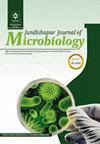沙特阿拉伯Aljouf Sakaka市健康献血者抗单纯疱疹病毒1型IgG血清阳性率的估计
IF 0.5
4区 医学
Q4 MICROBIOLOGY
引用次数: 0
摘要
背景:1型单纯疱疹病毒(HSV-1)是一种高度传染性的嗜神经病毒。关于沙特阿拉伯1型单纯疱疹病毒感染的数据,包括1型单纯疱疹病毒抗体的血清流行率,都是稀缺的。目的:这是首个评估沙特阿拉伯Aljouf Sakaka地区捐献血液中抗hsv -1免疫球蛋白G (IgG)流行率的研究。方法:从Sakaka市Mutaib Bin Abdulaziz王子医院血库采集300份献血标本。采用灵敏特异的酶联免疫吸附试验(ELISA)检测抗hsv -1 IgG。比较分层献血者的年龄、性别、受教育程度、职业、收入、手卫生、旅行史、拔罐习惯等对抗hsv -1 IgG水平的影响。结果:抗hsv -1 IgG阳性率较低(20%;N = 60/300)。此外,50.0%的igg阳性参与者年龄在41 - 45岁之间,81.7%的参与者家庭收入< 10000 SAR(统计学高度显著;P < 0.001*)。所有参与者在处理食物前和如厕后都用肥皂洗手。此外,igg阳性的参与者中,本科学历(50.0%)、政府工作人员(60.0%)、国际旅行者(50.0%)和拔罐者(50.0%)的相关性有统计学意义(P < 0.05*)。结论:目前的研究结果支持先前的报告,即改善社会经济条件和卫生措施对减少1型单纯疱疹病毒的传播至关重要。目前的研究为达到性处子年龄而没有获得保护性的抗HSV-1免疫球蛋白提供了警告,因此更容易通过生殖器途径获得HSV-1感染。这些数据支持迫切需要开发一种有效的抗单纯疱疹病毒1型疫苗。本文章由计算机程序翻译,如有差异,请以英文原文为准。
Estimation of Seroprevalence of Anti-Herpes Simplex Virus Type-1 IgG Among Healthy Blood Donors in Sakaka City, Aljouf, Saudi Arabia
Background: Herpes simplex virus type-1 (HSV-1) is a highly infectious neurotropic virus. The data on HSV-1 infection in Saudi Arabia, including the seroprevalence of HSV-1 antibodies, are scarce. Objectives: This is the first study to evaluate the prevalence of anti-HSV-1 immunoglobulin G (IgG) in donated blood in Sakaka, Aljouf, Saudi Arabia. Methods: A total of 300 donated blood samples were collected from the Blood Bank of Prince Mutaib Bin Abdulaziz Hospital in Sakaka. Sensitive and specific enzyme-linked immunosorbent assay (ELISA) was used to detect anti-HSV-1 IgG. A comparison of the age, gender, education, occupation, income, hand hygiene, travel history, and cupping practice of blood donors stratified for the extent of anti-HSV-1 IgG was made. Results: There was a low prevalence of anti-HSV-1 IgG (20%; n = 60/300). Moreover, 50.0% of IgG-positive participants were in the age group of 41 - 45 years, and 81.7% of the participants had a household income of < 10000 SAR (statistically highly significant; P < 0.001*). All the participants performed hand washing with soap before handling food and after using the toilet. Furthermore, IgG-positive participants had a bachelor’s degree (50.0%), were governmental employees (60.0%), were international travelers (50.0%), and practiced cupping (50.0%) with statistically significant associations (P < 0.05*). Conclusions: The current study’s findings support previous reports about the key importance of improving socioeconomic conditions and hygiene measures in reducing the spread of HSV-1. The present study provides an alarm regarding reaching the age of sexual debut without acquiring protective anti-HSV-1 immunoglobulins, consequently becoming more susceptible to acquiring HSV-1 infection through the genital route. These data support the urgent need to develop an effective anti-HSV-1 vaccine.
求助全文
通过发布文献求助,成功后即可免费获取论文全文。
去求助
来源期刊

Jundishapur Journal of Microbiology
MICROBIOLOGY-
CiteScore
1.30
自引率
0.00%
发文量
56
审稿时长
6-12 weeks
期刊介绍:
Jundishapur Journal of Microbiology, (JJM) is the official scientific Monthly publication of Ahvaz Jundishapur University of Medical Sciences. JJM is dedicated to the publication of manuscripts on topics concerning all aspects of microbiology. The topics include medical, veterinary and environmental microbiology, molecular investigations and infectious diseases. Aspects of immunology and epidemiology of infectious diseases are also considered.
 求助内容:
求助内容: 应助结果提醒方式:
应助结果提醒方式:


